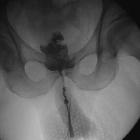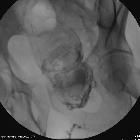Enterocutaneous fistula



An enterocutaneous fistula is an abnormal connection between a loop of bowel and the skin. They occur most commonly secondary to abdominal surgery. Other less common etiologies are chronic inflammatory bowel diseases, tumors, and radiation enteritis.
Radiographic features
CT
CT is the most common modality used for assessment of enterocutaneous fistulas, especially with the use of fistulography. The injection of positive contrast well-delineates the fistulous tract and its branching pattern and connections. CT also enables multiplanar reconstruction and thin cuts for good anatomical details. CT is also helpful for assessment of adjacent soft tissues, identifying associated abscesses and features of possible non-surgical etiologies like inflammatory bowel diseases.
MRI
MRI has superior soft-tissue contrast compared to CT and therefore it is better to define the fistulous tract. It delineates the tract as a fluid-filled tract, especially on the use of fat suppression techniques. The tract wall appears hypointense in T1 and T2. The use of contrast helps for more delineation of the tract wall with tram track enhancement and the presence of an associated abscess.
Siehe auch:

 Assoziationen und Differentialdiagnosen zu enterokutane Fistel:
Assoziationen und Differentialdiagnosen zu enterokutane Fistel:

